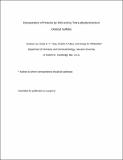| dc.contributor.author | Lee, Andrew | |
| dc.contributor.author | Tang, Sindy K. Y. | |
| dc.contributor.author | Mace, Charles R. | |
| dc.contributor.author | Whitesides, George McClelland | |
| dc.date.accessioned | 2014-09-30T15:58:03Z | |
| dc.date.issued | 2011 | |
| dc.identifier.citation | Lee, Andrew, Sindy K. Y. Tang, Charles R. Mace, and George M. Whitesides. 2011. “Denaturation of Proteins by SDS and Tetraalkylammonium Dodecyl Sulfates.” Langmuir 27, no. 18: 11560–11574. | en_US |
| dc.identifier.issn | 0743-7463 | en_US |
| dc.identifier.uri | http://nrs.harvard.edu/urn-3:HUL.InstRepos:12967698 | |
| dc.description.abstract | This article describes the use of capillary electrophoresis (CE) to examine the influence of different cations (C(+); C(+) = Na(+) and tetra-n-alkylammonium, NR(4)(+), where R = Me, Et, Pr, and Bu) on the rates of denaturation of bovine carbonic anhydrase II (BCA) in the presence of anionic surfactant dodecylsulfate (DS(-)). An analysis of the denaturation of BCA in solutions of Na(+)DS(-) and NR(4)(+)DS(-) (in Tris-Gly buffer) indicated that the rates of formation of complexes of denatured BCA with DS(-) (BCA(D)-DS(-)(n,sat)) are indistinguishable and independent of the cation below the critical micellar concentration (cmc) and independent of the total concentration of DS(-) above the cmc. At concentrations of C(+)DS(-) above the cmc, BCA denatured at rates that depended on the cation; the rates decreased by a factor >10(4) in the order of Na(+) ≈ NMe(4)(+) > NEt(4)(+) > NPr(4)(+) > NBu(4)(+), which is the same order as the values of the cmc (which decrease from 4.0 mM for Na(+)DS(-) to 0.9 mM for NBu(4)(+)DS(-) in Tris-Gly buffer). The relationship between the cmc values and the rates of formation of BCA(D)-DS(-)(n,sat()) suggested that the kinetics of denaturation of BCA involve the association of this protein with monomeric DS(-) rather than with micelles of (C(+)DS(-))(n). A less-detailed survey of seven other proteins (α-lactalbumin, β-lactoglobulin A, β-lactoglobulin B, carboxypeptidase B, creatine phosphokinase, myoglobin, and ubiquitin) showed that the difference between Na(+)DS(-) and NR(4)(+)DS(-) observed with BCA was not general. Instead, the influence of NR(4)(+) on the association of DS(-) with these proteins depended on the protein. The selection of the cation contributed to the properties (including the composition, electrophoretic mobility, and partitioning behavior in aqueous two-phase systems) of aggregates of denatured protein and DS(-). These results suggest that the variation in the behavior of NR(4)(+)DS(-) with changes in R may be exploited in methods used to analyze and separate mixtures of proteins. | en_US |
| dc.description.sponsorship | Chemistry and Chemical Biology | en_US |
| dc.language.iso | en_US | en_US |
| dc.publisher | American Chemical Society (ACS) | en_US |
| dc.relation.isversionof | doi:10.1021/la201832d | en_US |
| dash.license | OAP | |
| dc.title | Denaturation of Proteins by SDS and Tetraalkylammonium Dodecyl Sulfates | en_US |
| dc.type | Journal Article | en_US |
| dc.description.version | Accepted Manuscript | en_US |
| dc.relation.journal | Langmuir | en_US |
| dash.depositing.author | Whitesides, George McClelland | |
| dc.date.available | 2014-09-30T15:58:03Z | |
| dc.identifier.doi | 10.1021/la201832d | * |
| dash.contributor.affiliated | Whitesides, George | |
| dc.identifier.orcid | 0000-0001-9451-2442 | |


